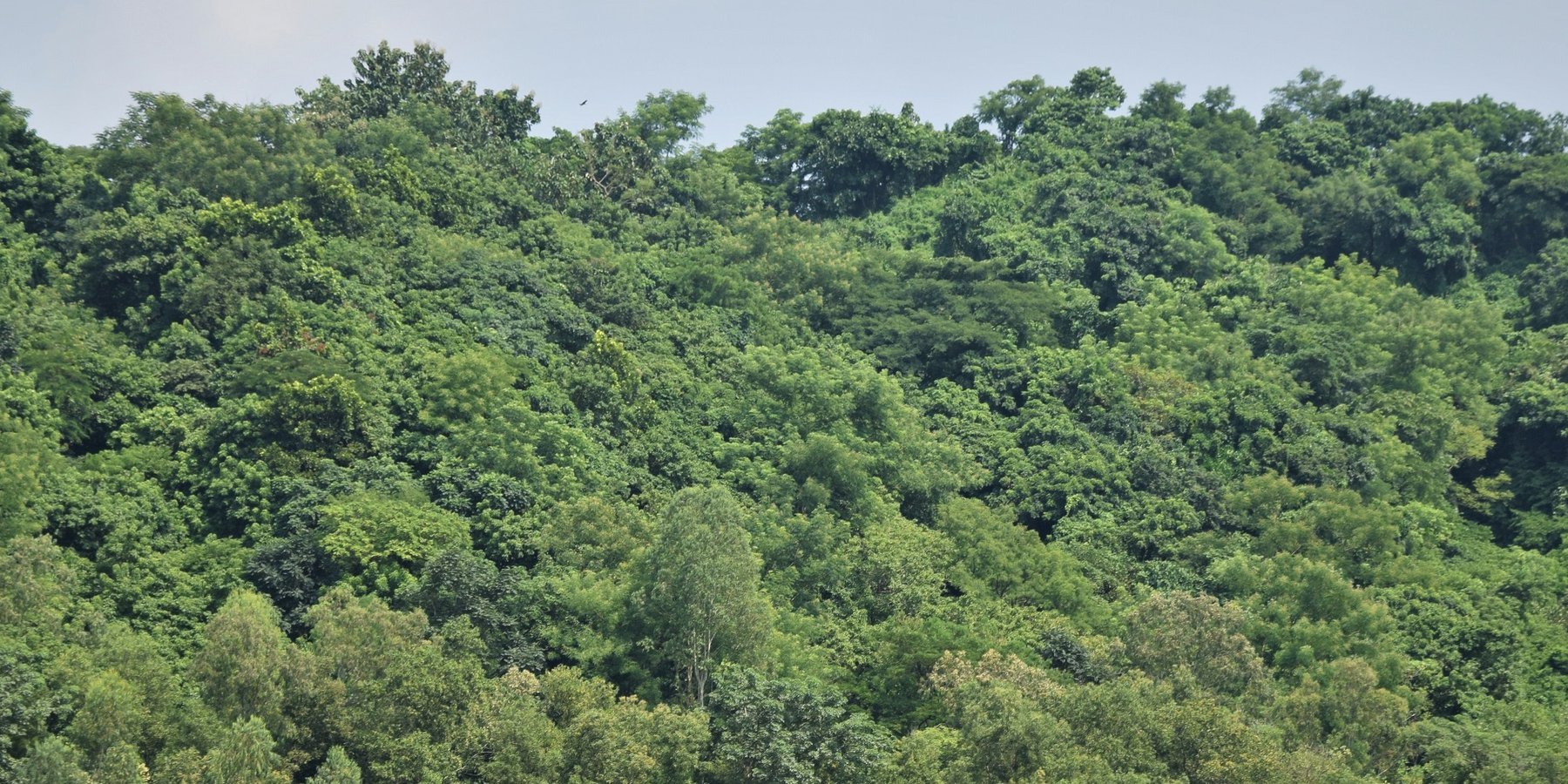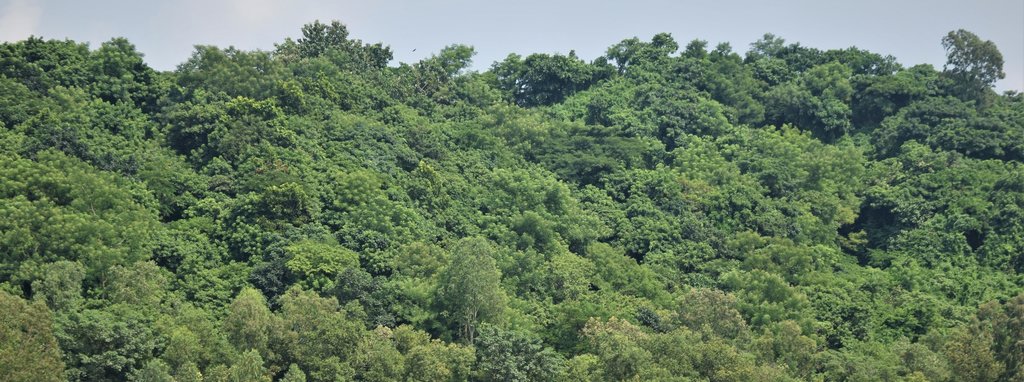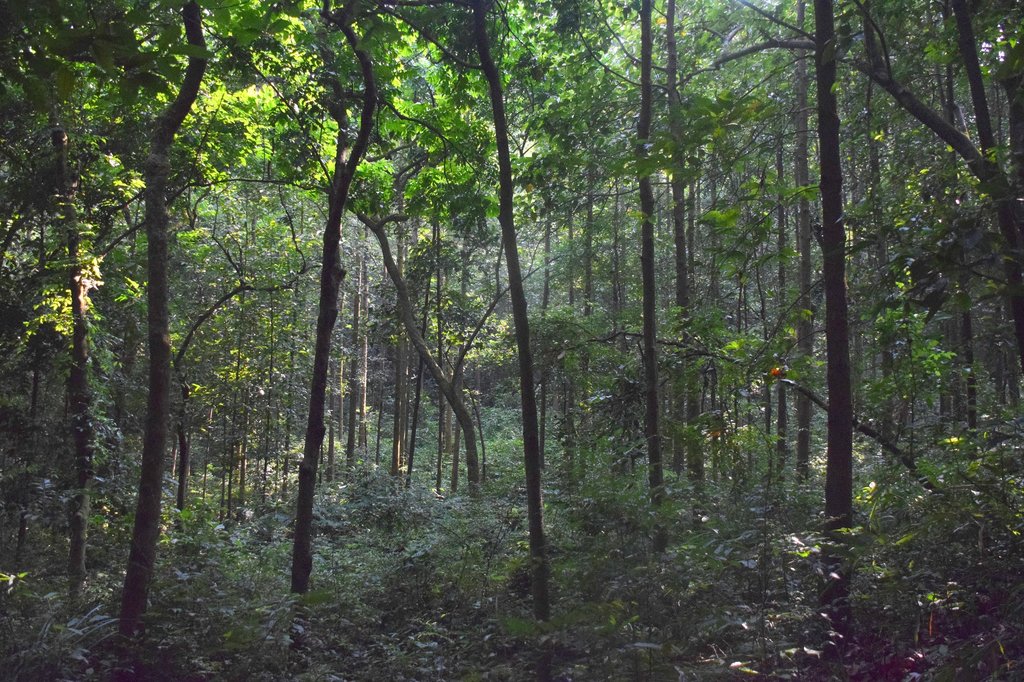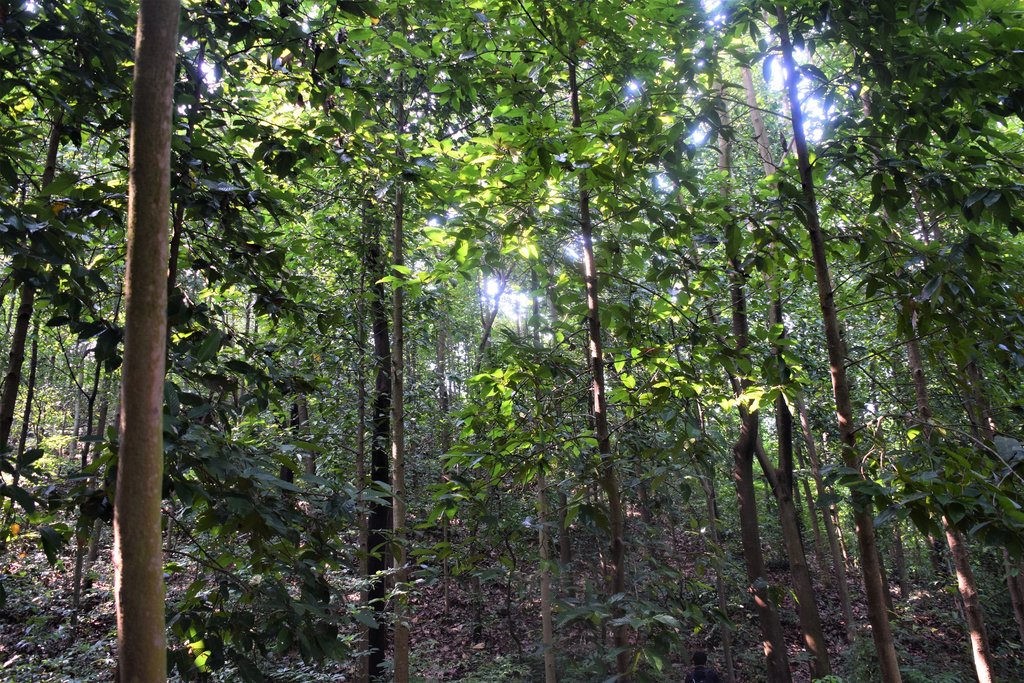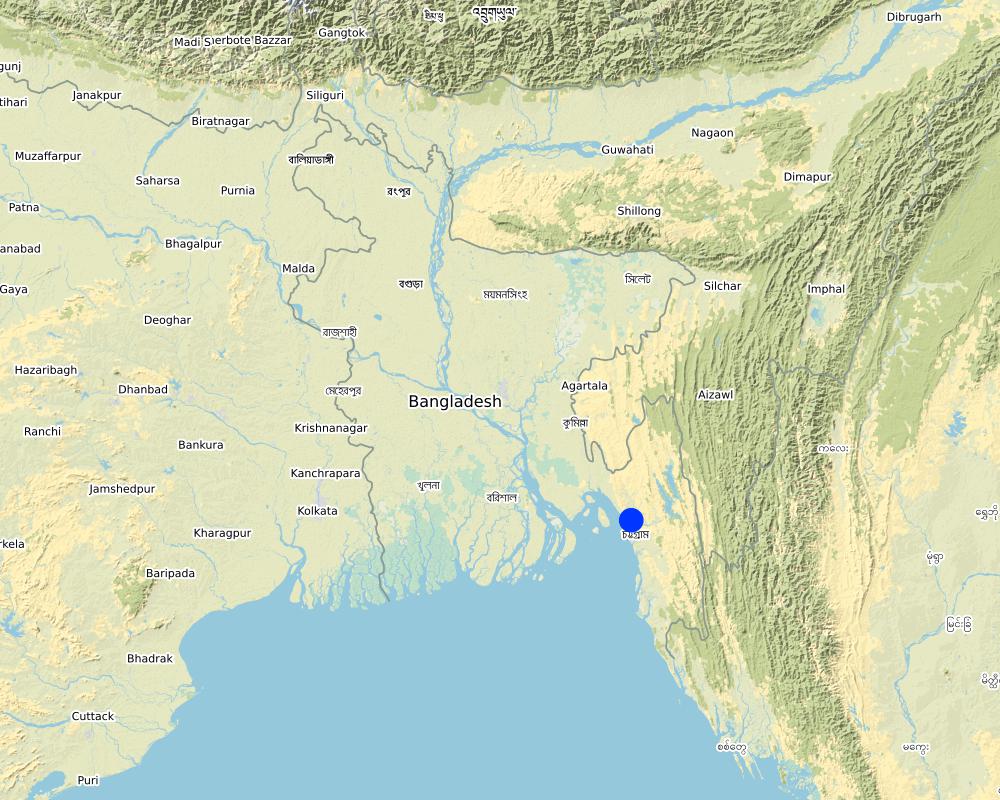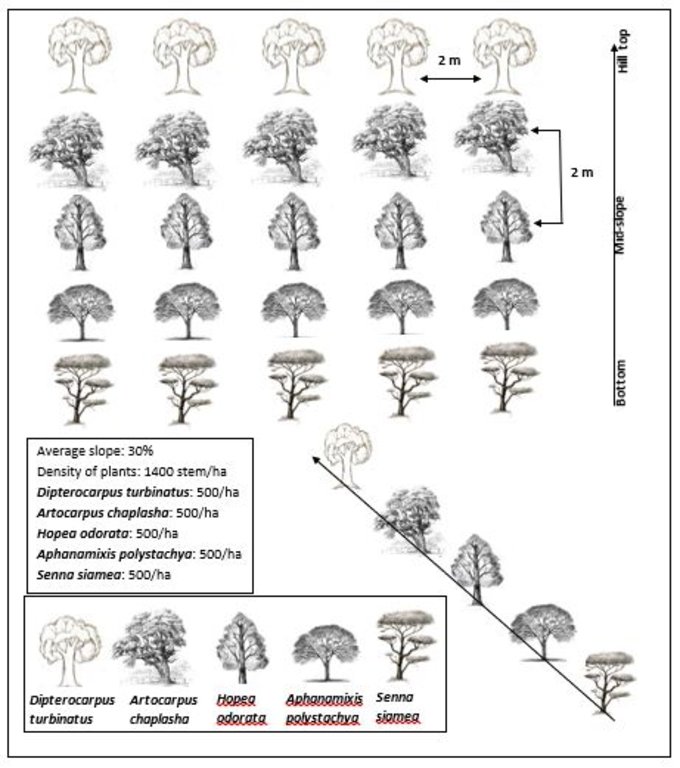Mixed plantation with slow growing indigenous species to protect land degradation [บังกลาเทศ]
- ผู้สร้างสรรค์:
- การอัพเดท:
- ผู้รวบรวม: Fazlay Arafat
- ผู้เรียบเรียง: –
- ผู้ตรวจสอบ: Nicole Harari, Rima Mekdaschi Studer, Ursula Gaemperli
Desi Projatir Misro Bagan
technologies_4329 - บังกลาเทศ
ดูส่วนย่อย
ขยายทั้งหมด ย่อทั้งหมด1. ข้อมูลทั่วไป
1.2 รายละเอียดที่ติดต่อได้ของผู้รวบรวมและองค์กรที่เกี่ยวข้องในการประเมินและการจัดเตรียมทำเอกสารของเทคโนโลยี
วิทยากรหลัก
ผู้ใช้ที่ดิน:
Hossain Md. Akhter
Institute of Forestry and Environmental Sciences, University of Chittagong
บังกลาเทศ
ผู้ใช้ที่ดิน:
Alam Md. Bodiul
University of Chittagong
บังกลาเทศ
ชื่อของโครงการซึ่งอำนวยความสะดวกในการทำเอกสารหรือการประเมินเทคโนโลยี (ถ้าเกี่ยวข้อง)
Decision Support for Mainstreaming and Scaling out Sustainable Land Management (GEF-FAO / DS-SLM)ชื่อขององค์กรซึ่งอำนวยความสะดวกในการทำเอกสารหรือการประเมินเทคโนโลยี (ถ้าเกี่ยวข้อง)
Bangladesh Forest Department (Bangladesh Forest Department) - บังกลาเทศ1.3 เงื่อนไขการใช้ข้อมูลที่ได้บันทึกผ่านทาง WOCAT
ผู้รวบรวมและวิทยากรหลักยอมรับเงื่อนไขเกี่ยวกับการใช้ข้อมูลที่ถูกบันทึกผ่านทาง WOCAT:
ใช่
1.4 การเปิดเผยเรื่องความยั่งยืนของเทคโนโลยีที่ได้อธิบายไว้
เทคโนโลยีที่ได้อธิบายไว้นี้เป็นปัญหาของความเสื่อมโทรมโทรมของที่ดินหรือไม่ จึงไม่ได้รับการยอมรับว่าเป็นเทคโนโลยีเพื่อการจัดการที่ดินอย่างยั่งยืน:
ไม่ใช่
2. การอธิบายลักษณะของเทคโนโลยี SLM
2.1 การอธิบายแบบสั้น ๆ ของเทคโนโลยี
คำจำกัดความของเทคโนโลยี:
Mixed plantation technique with slow growing indigenous plant species in hill slope, that plays an important role to protect land degradation.
2.2 การอธิบายแบบละเอียดของเทคโนโลยี
คำอธิบาย:
Mixed-species plantations can play an important role in regulating land degradation and sustainable management of degraded forest areas. Among the various forestry practices, planting fast-growing species (used in mono-culture plantation) with slow-growing and indigenous species has a positive long-term impact on forest land management. Mixed species tree plantations have the potential to improve forest soils, forest cover and biological diversity, and facilitate forest succession in degraded ecosystems. In addition to carbon accumulation, mixed plantations also increase understory plant regeneration, and in some cases, reduce diseases and pests infestation in plantation. This technology is applied in hill-forest areas in Bangladesh for preventing erosion and risk of landslides, and to provide a sustainable supply of timber and fuel wood.
The plantation site located in Hathazari area of Chittagong division and inside the periphery of University of Chittagong. The landform is hill slope with 16-30% slopes on average. The annual rainfall is around 2500 mm and the soil texture is loamy to silty. The species used at the Hathazari plantation site were: Garjan (Dipterocarpus turbinatus), Telsur (Hopea odorata), Chapalish (Artocarpus chaplasha), Pithraj (Aphanamixis polystachya), and Minjiri (Senna siamea). All are deep-rooted, slow growing indigenous plant species with a felling rotation of 25-30 years. The Dipterocarpus species grows well on top of hill whereas Artocarpus chaplasha and Hopea odorata grows well in mid slope. Aphanamixis polystachya and Senna siamea perform well in bottom layer of hill. The sequence has positive mutual effects on tree growing. The plantation was established and managed by the authority of University of Chittagong (owner of the land) in 1990 with 2500 trees planted per hectare area (spacing interval 2m x 2m). The average slope of the site is around 30%. Before reforestation, the land was degraded and unproductive. As only a few scattered trees grow due to a huge demand of fuel wood the resulting insufficient coverage by tree crowns frequently led to landslides in the area. The local communities are only allowed to collect the dead branches as fuel and other non-wood forest products like honey, mushrooms, fruits and fodders from the plantation site.
The major activities required to establish the plantation are: seed collection, nursery preparation, site preparation, pit preparation, planting, tying of plants to stick for support, application of fertilizer, compost and biocide. After first establishment, the plantation needs ongoing maintenance activities such as weeding, refilling of vacancies, thinning, pruning, application of fertilizers and biocides (if necessary) and cutting of climbers. The timber species undergo a variety of thinning practices before the entire stand reaches maturity. These trees are progressively thinned out to provide fuel wood and timber, while allowing room for the natural regeneration of native species. The university authority carried out the maintenance activities and such a practice is advantageous to adjacent local communities since it meets their fuel wood demand.
Prior to establishment of the plantation, the area was barren and unproductive, and was hardly a suitable habitat for wildlife. More critically, during the annual monsoons, landslides were a regular phenomenon. The natural regeneration of the deforested area was additionally hampered by incendiary fires set by local communities for agricultural purpose. After the establishment of the plantation and the subsequent improvement of forest/land cover, it is now a habit for various species of bird, monkeys, deer, wild pigs, and rabbits. Furthermore, in humid tropical regions like Bangladesh, the frequent litterfall from indigenous plant species in mixed plantations constitutes the bulk of soil organic matter, and improved nutrient availability and soil fertility.
Though the mixed plantation required intensive management in the early stage, the example of this plantation shows that the mixed plantation with indigenous species is worthwhile and a degraded area can fully recover after 20 years. However, illicit felling of timber trees and illegal removal of litters from the ground for fuel by the local communities are still remains as a management challenge. The practice retains ecological integrity and enhances human well-being (through ‘cultural’ ecosystem services such as aesthetic beauty, ecotourism etc.) and livelihood (timber, fuelwood, non-timber forest products) as well.
2.3 รูปภาพของเทคโนโลยี
2.5 ประเทศภูมิภาค หรือสถานที่ตั้งที่เทคโนโลยีได้นำไปใช้และได้รับการครอบคลุมโดยการประเมินนี้
ประเทศ:
บังกลาเทศ
ภูมิภาค/รัฐ/จังหวัด:
Chittagong division
ข้อมูลจำเพาะเพิ่มเติมของสถานที่ตั้ง :
Hathazari
ระบุการกระจายตัวของเทคโนโลยี:
- กระจายไปอย่างสม่ำเสมอในพื้นที่
If precise area is not known, indicate approximate area covered:
- 0.1-1 ตร.กม.
Is/are the technology site(s) located in a permanently protected area?
ไม่ใช่
Map
×2.6 วันที่การดำเนินการ
ระบุปีที่ใช้:
1990
2.7 คำแนะนำของเทคโนโลยี
ให้ระบุว่าเทคโนโลยีถูกแนะนำเข้ามาอย่างไร:
- ในช่วงการทดลองหรือการทำวิจัย
3. การจัดประเภทของเทคโนโลยี SLM
3.1 วัตถุประสงค์หลักของเทคโนโลยี
- ปรับปรุงการผลิตให้ดีขึ้น
- ลด ป้องกัน ฟื้นฟู การเสื่อมโทรมของที่ดิน
- อนุรักษ์ระบบนิเวศน์
- ลดความเสี่ยงของภัยพิบัติ
- สร้างผลกระทบทางด้านสังคมที่เป็นประโยชน์
3.2 ประเภทของการใช้ที่ดินในปัจจุบันที่ได้นำเทคโนโลยีไปใช้
Land use mixed within the same land unit:
ไม่ใช่

ป่า/พื้นที่ทำไม้
- ป่า/พื้นที่ทำไม้
Tree plantation, afforestation: Specify origin and composition of species:
- การปลูกหลายพันธุ์รวมกัน
Type of tree plantation, afforestation:
- tropical rain forest plantation
- Garjan (Dipterocarpus turbinatus), Telsur (Hopea odorata), Chapalish (Artocarpus Chaplasha), Pithraj (Aphanamixis polystachya), Minjiri (Senna siamea), etc.
Are the trees specified above deciduous or evergreen?
- mixed deciduous/ evergreen
ผลิตภัณฑ์และบริการ:
- ไม้ซุง
- ไม้ที่นำมาทำเป็นเชื้อเพลิง
- การอนุรักษ์ / ป้องกันธรรมชาติ
- นันทนาการ / การท่องเที่ยว
- การป้องกันภัยธรรมชาติ
3.3 Has land use changed due to the implementation of the Technology?
Has land use changed due to the implementation of the Technology?
- Yes (Please fill out the questions below with regard to the land use before implementation of the Technology)
Land use mixed within the same land unit:
ไม่ใช่

ที่ดินที่ไม่ให้ผลผลิต
ระบุ:
The area was unproductive with some scatter trees that grows naturally. Due to huge demand of fuel wood the few natural stands also faced tremendous pressure. As the canopy coverage was exposed, landslides occurred frequently in that area.
3.4 การใช้น้ำ
การใช้น้ำของที่ดินที่มีการใช้เทคโนโลยีอยู่:
- จากน้ำฝน
3.5 กลุ่ม SLM ที่ตรงกับเทคโนโลยีนี้
- การจัดการสวนป่า
- การปรับปรุงดิน / พืชคลุมดิน
- การลดความเสี่ยงจากภัยพิบัติบนพื้นฐานของระบบนิเวศ
3.6 มาตรการ SLM ที่ประกอบกันเป็นเทคโนโลยี

มาตรการอนุรักษ์ด้วยวิธีพืช
- V1: ต้นไม้และพุ่มไม้คลุมดิน
3.7 รูปแบบหลักของการเสื่อมโทรมของที่ดินที่ได้รับการแก้ไขโดยเทคโนโลยี

การกัดกร่อนของดินโดยน้ำ
- Wt (Loss of topsoil): การสูญเสียดินชั้นบนหรือการกัดกร่อนที่ผิวดิน
- Wg (Gully erosion): การกัดกร่อนแบบร่องธารหรือการทำให้เกิดร่องน้ำเซาะ
- Wm (Mass movement): การเคลื่อนตัวของมวลดินหรือดินถล่ม
3.8 การป้องกัน การลดลง หรือการฟื้นฟูความเสื่อมโทรมของที่ดิน
ระบุเป้าหมายของเทคโนโลยีกับความเสื่อมโทรมของที่ดิน:
- ลดความเสื่อมโทรมของดิน
4. ข้อมูลจำเพาะด้านเทคนิค กิจกรรมการนำไปปฏิบัติใช้ ปัจจัยนำเข้า และค่าใช้จ่าย
4.1 แบบแปลนทางเทคนิคของเทคโนโลยี
ข้อมูลจำเพาะด้านเทคนิค (แบบแปลนทางเทคนิคของเทคโนโลยี):
The dimensions of structures are explained in the description part.
ผู้เขียน:
Md. Fazlay Arafat
วันที่:
13/09/2018
4.2 ข้อมูลทั่วไปเกี่ยวกับการคำนวณปัจจัยนำเข้าและค่าใช้จ่าย
ให้ระบุว่าค่าใช้จ่ายและปัจจัยนำเข้าได้รับการคำนวณอย่างไร:
- ต่อพื้นที่ที่ใช้เทคโนโลยี
ระบุขนาดและหน่วยพื้นที่:
hectare
If using a local area unit, indicate conversion factor to one hectare (e.g. 1 ha = 2.47 acres): 1 ha =:
2.47 acres
อื่นๆ หรือสกุลเงินประจำชาติ (ระบุ):
BDT
If relevant, indicate exchange rate from USD to local currency (e.g. 1 USD = 79.9 Brazilian Real): 1 USD =:
83.0
ระบุค่าเฉลี่ยของค่าจ้างในการจ้างแรงงานต่อวัน:
500
4.3 กิจกรรมเพื่อการจัดตั้ง
| กิจกรรม | Timing (season) | |
|---|---|---|
| 1. | Nursery preparation (seed collection, site clearing, leveling and fencing, drainage arrangement, bed preparation, making overhead shed, poly-bag preparation, potting seeds, manuring, irrigation, weed control) | October |
| 2. | Site preparation (prepare plantation site map with GPS, jungle cutting, debris collection and staging, preparation of inspection paths and fire lines) | May |
| 3. | Plantation (pit preparation, tying up of plants, application of fertilizers, compost and biocide, stick for support) | June-July |
4.4 ค่าใช้จ่ายของปัจจัยนำเข้าที่จำเป็นสำหรับการจัดตั้ง
| ปัจจัยนำเข้า | หน่วย | ปริมาณ | ค่าใช้จ่ายต่อหน่วย | ค่าใช้จ่ายทั้งหมดต่อปัจจัยนำเข้า | %ของค่าใช้จ่ายที่ก่อให้เกิดขึ้นโดยผู้ใช้ที่ดิน | |
|---|---|---|---|---|---|---|
| แรงงาน | Nursery work | Person day | 32.0 | 500.0 | 16000.0 | 100.0 |
| แรงงาน | Site preparation | Person day | 20.0 | 500.0 | 10000.0 | 100.0 |
| แรงงาน | Plantation | Person day | 40.0 | 500.0 | 20000.0 | 100.0 |
| อุปกรณ์ | Polybags | Pieces | 3000.0 | 1.0 | 3000.0 | 100.0 |
| อุปกรณ์ | Loamy soil | Cubic meter | 6.0 | 400.0 | 2400.0 | 100.0 |
| อุปกรณ์ | Bamboo | Pieces | 7.0 | 600.0 | 4200.0 | 100.0 |
| อุปกรณ์ | Stick | Pieces | 2600.0 | 2.0 | 5200.0 | 100.0 |
| อุปกรณ์ | Rope | Lump sum | 1.0 | 200.0 | 200.0 | 100.0 |
| อุปกรณ์ | Bucket, Spade, Knife | Lump sum | 1.0 | 1000.0 | 1000.0 | 100.0 |
| วัสดุด้านพืช | Seeds | Kg | 2.0 | 500.0 | 1000.0 | 100.0 |
| ปุ๋ยและสารฆ่า/ยับยั้งการเจริญเติบโตของสิ่งมีชีวิต (ไบโอไซด์) | Urea | Kg | 12.0 | 35.0 | 420.0 | 100.0 |
| ปุ๋ยและสารฆ่า/ยับยั้งการเจริญเติบโตของสิ่งมีชีวิต (ไบโอไซด์) | TSP | Kg | 12.0 | 40.0 | 480.0 | 100.0 |
| ปุ๋ยและสารฆ่า/ยับยั้งการเจริญเติบโตของสิ่งมีชีวิต (ไบโอไซด์) | MoP | Kg | 12.0 | 30.0 | 360.0 | 100.0 |
| ปุ๋ยและสารฆ่า/ยับยั้งการเจริญเติบโตของสิ่งมีชีวิต (ไบโอไซด์) | Compost | Kg | 3200.0 | 4.0 | 12800.0 | 100.0 |
| ปุ๋ยและสารฆ่า/ยับยั้งการเจริญเติบโตของสิ่งมีชีวิต (ไบโอไซด์) | Biocide | Lump Sum | 1.0 | 200.0 | 200.0 | 100.0 |
| วัสดุสำหรับก่อสร้าง | Signboard (to demarcate plantation area, number of species planted and year of plantation) | Pieces | 1.0 | 1000.0 | 1000.0 | 100.0 |
| ค่าใช้จ่ายทั้งหมดของการจัดตั้งเทคโนโลยี | 78260.0 | |||||
| Total costs for establishment of the Technology in USD | 942.89 | |||||
แสดงความคิดเห็น:
The University of Chittagong is the land user here.
4.5 การบำรุงรักษาสภาพหรือกิจกรรมที่เกิดขึ้นเป็นประจำ
| กิจกรรม | ช่วงระยะเวลา/ความถี่ | |
|---|---|---|
| 1. | 1st year weeding and climber cutting | 3 times in a year |
| 2. | 2nd year weeding, climber cutting and thinning | 3 times in a year |
| 3. | 3rd year weeding, climber cutting, thinning and pruning | 3 times in a year |
| 4. | 1st year Vacancy filling, fertilizer and compost application | June-July |
| 5. | 2nd year Vacancy filling, fertilizer and compost application | June-July |
4.6 ค่าใช้จ่ายของปัจจัยนำเข้าและกิจกรรมที่เกิดขึ้นเป็นประจำที่ต้องการการบำรุงรักษา (ต่อปี)
| ปัจจัยนำเข้า | หน่วย | ปริมาณ | ค่าใช้จ่ายต่อหน่วย | ค่าใช้จ่ายทั้งหมดต่อปัจจัยนำเข้า | %ของค่าใช้จ่ายที่ก่อให้เกิดขึ้นโดยผู้ใช้ที่ดิน | |
|---|---|---|---|---|---|---|
| แรงงาน | 1st year weeding and climber cutting | person-day | 21.0 | 500.0 | 10500.0 | 100.0 |
| แรงงาน | 2nd year weeding, climber cutting and thinning | person-day | 21.0 | 500.0 | 10500.0 | 100.0 |
| แรงงาน | 3rd year weeding, climber cutting, thinning and pruning | person-day | 12.0 | 500.0 | 6000.0 | 100.0 |
| แรงงาน | Vacancy filling, fertilizer and compost application 2 times | person-day | 30.0 | 500.0 | 15000.0 | 100.0 |
| วัสดุด้านพืช | Seedlings | pieces | 500.0 | 10.0 | 5000.0 | 100.0 |
| ปุ๋ยและสารฆ่า/ยับยั้งการเจริญเติบโตของสิ่งมีชีวิต (ไบโอไซด์) | Urea, TSP, MoP, Compost | Lump sum | 1.0 | 1000.0 | 1000.0 | 100.0 |
| ค่าใช้จ่ายทั้งหมดของการบำรุงรักษาสภาพเทคโนโลยี | 48000.0 | |||||
| Total costs for maintenance of the Technology in USD | 578.31 | |||||
4.7 ปัจจัยสำคัญที่สุดที่มีผลกระทบต่อค่าใช้จ่าย
ปัจจัยสำคัญที่สุดที่มีผลกระทบต่อค่าใช้จ่ายต่างๆ:
Labor cost
5. สิ่งแวดล้อมทางธรรมชาติและของมนุษย์
5.1 ภูมิอากาศ
ฝนประจำปี
- < 250 ม.ม.
- 251-500 ม.ม.
- 501-750 ม.ม.
- 751-1,000 ม.ม.
- 1,001-1,500 ม.ม.
- 1,501-2,000 ม.ม.
- 2,001-3,000 ม.ม.
- 3,001-4,000 ม.ม.
- > 4,000 ม.ม.
เขตภูมิอากาศเกษตร
- ชื้น
5.2 สภาพภูมิประเทศ
ค่าเฉลี่ยความลาดชัน:
- ราบเรียบ (0-2%)
- ลาดที่ไม่ชัน (3-5%)
- ปานกลาง (6-10%)
- เป็นลูกคลื่น (11-15%)
- เป็นเนิน (16-30%)
- ชัน (31-60%)
- ชันมาก (>60%)
ธรณีสัณฐาน:
- ที่ราบสูง/ที่ราบ
- สันเขา
- ไหล่เขา
- ไหล่เนินเขา
- ตีนเนิน
- หุบเขา
ระดับความสูง:
- 0-100 เมตร
- 101-500 เมตร
- 501-1,000 เมตร
- 1,001-1,500 เมตร
- 1,501-2,000 เมตร
- 2,001-2,500 เมตร
- 2,501-3,000 เมตร
- 3,001-4,000 เมตร
- > 4,000 เมตร
ให้ระบุถ้าเทคโนโลยีได้ถูกนำไปใช้:
- ไม่เกี่ยวข้อง
5.3 ดิน
ค่าเฉลี่ยความลึกของดิน:
- ตื้นมาก (0-20 ซ.ม.)
- ตื้น (21-50 ซ.ม.)
- ลึกปานกลาง (51-80 ซ.ม.)
- ลึก (81-120 ซ.ม.)
- ลึกมาก (>120 ซ.ม.)
เนื้อดิน (ดินชั้นบน):
- ปานกลาง (ดินร่วน ทรายแป้ง)
เนื้อดินล่าง (> 20 ซ.ม.ต่ำจากผิวดิน):
- ปานกลาง (ดินร่วน ทรายแป้ง)
อินทรียวัตถุในดิน:
- ปานกลาง (1-3%)
5.4 ความเป็นประโยชน์และคุณภาพของน้ำ
ระดับน้ำใต้ดิน:
5-50 เมตร
น้ำไหลบ่าที่ผิวดิน:
ปานกลาง
คุณภาพน้ำ (ที่ยังไม่ได้บำบัด):
เป็นน้ำเพื่อการดื่มที่ไม่ดี (จำเป็นต้องได้รับการบำบัด)
Water quality refers to:
surface water
ความเค็มของน้ำเป็นปัญหาหรือไม่:
ไม่ใช่
กำลังเกิดน้ำท่วมในพื้นที่หรือไม่:
ไม่ใช่
5.5 ความหลากหลายทางชีวภาพ
ความหลากหลายทางชนิดพันธุ์:
- ปานกลาง
ความหลากหลายของแหล่งที่อยู่:
- ต่ำ
5.6 ลักษณะของผู้ใช้ที่ดินที่นำเทคโนโลยีไปปฏิบัติใช้
อยู่กับที่หรือเร่ร่อน:
- อยู่กับที่
แนวทางการตลาดของระบบการผลิต:
- mixed (subsistence/ commercial)
รายได้ที่มาจากนอกฟาร์ม:
- < 10% ของรายได้ทั้งหมด
ระดับของความมั่งคั่งโดยเปรียบเทียบ:
- พอมีพอกิน
เป็นรายบุคคล/ครัวเรือน:
- ลูกจ้าง (บริษัท รัฐบาล)
ระดับของการใช้เครื่องจักรกล:
- งานที่ใช้แรงกาย
เพศ:
- หญิง
- ชาย
อายุของผู้ใช้ที่ดิน:
- ผู้เยาว์
- วัยกลางคน
5.7 Average area of land used by land users applying the Technology
- < 0.5 เฮกตาร์
- 0.5-1 เฮกตาร์
- 1-2 เฮกตาร์
- 2-5 เฮกตาร์
- 5-15 เฮกตาร์
- 15-50 เฮกตาร์
- 50-100 เฮกตาร์
- 100-500 เฮกตาร์
- 500-1,000 เฮกตาร์
- 1,000-10,000 เฮกตาร์
- >10,000 เฮกตาร์
พิจารณาว่าเป็นขนาดเล็ก กลาง หรือขนาดใหญ่ (ซึ่งอ้างอิงถึงบริบทระดับท้องถิ่น):
- ขนาดกลาง
5.8 กรรมสิทธิ์ในที่ดิน สิทธิในการใช้ที่ดินและสิทธิในการใช้น้ำ
กรรมสิทธิ์ในที่ดิน:
- รัฐ
สิทธิในการใช้ที่ดิน:
- รายบุคคล
สิทธิในการใช้น้ำ:
- เข้าถึงได้แบบเปิด (ไม่ได้จัดระเบียบ)
Are land use rights based on a traditional legal system?
ไม่ใช่
5.9 การเข้าถึงบริการและโครงสร้างพื้นฐาน
สุขภาพ:
- จน
- ปานกลาง
- ดี
การศึกษา:
- จน
- ปานกลาง
- ดี
ความช่วยเหลือทางด้านเทคนิค:
- จน
- ปานกลาง
- ดี
การจ้างงาน (เช่น ภายนอกฟาร์ม):
- จน
- ปานกลาง
- ดี
ตลาด:
- จน
- ปานกลาง
- ดี
พลังงาน:
- จน
- ปานกลาง
- ดี
ถนนและการขนส่ง:
- จน
- ปานกลาง
- ดี
น้ำดื่มและการสุขาภิบาล:
- จน
- ปานกลาง
- ดี
บริการด้านการเงิน:
- จน
- ปานกลาง
- ดี
6. ผลกระทบและสรุปคำบอกกล่าว
6.1 ผลกระทบในพื้นที่ดำเนินการ (On-site) จากการใช้เทคโนโลยี
ผลกระทบทางด้านเศรษฐกิจและสังคม
การผลิต
การผลิตไม้
คุณภาพป่า /พื้นที่ทำไม้
การผลิตของจากป่าทุกชนิดยกเว้นไม้
แสดงความคิดเห็น/ระบุ:
honey, mushrooms and fruits for wildlife
การเสี่ยงต่อความล้มเหลวในการผลิต
แสดงความคิดเห็น/ระบุ:
mixed plantation is more pest resistant
ความหลากหลายของผลิตภัณฑ์
แสดงความคิดเห็น/ระบุ:
Along with timber these mixed plantation yields oil, fruits, fodder, fuel and herbal medicines
พื้นที่สำหรับการผลิต
การจัดการที่ดิน
แสดงความคิดเห็น/ระบุ:
The degraded land which was vulnerable for landslides now convert to a native plantation area
ความเป็นประโยชน์และคุณภาพของน้ำ
การมีน้ำไว้ให้สำหรับการชลประทาน
แสดงความคิดเห็น/ระบุ:
Increase of the stream flow that used for irrigation in adjacent crop lands
คุณภาพน้ำสำหรับการชลประทาน
รายได้และค่าใช้จ่าย
ความหลากหลายของแหล่งผลิตรายได้
แสดงความคิดเห็น/ระบุ:
tourism promoted in the area
ภาระงาน
แสดงความคิดเห็น/ระบุ:
The workload increased at the initial stage but in the long run it will protect from the hassle of landslides
ผลกระทบด้านสังคมวัฒนธรรมอื่น ๆ
การใช้ที่ดิน / สิทธิในการใช้น้ำ
โอกาสทางด้านสันทนาการ
แสดงความคิดเห็น/ระบุ:
tourism increased in the area
SLM หรือความรู้เรื่องความเสื่อมโทรมของที่ดิน
ผลกระทบด้านนิเวศวิทยา
วัฐจักรน้ำหรือน้ำบ่า
ปริมาณน้ำ
แสดงความคิดเห็น/ระบุ:
water holding capacity of soil increased due to the increase organic matter in the soil and canopy coverage
คุณภาพน้ำ
น้ำไหลบ่าที่ผิวดิน
การระบายน้ำส่วนเกิน
น้ำบาดาลหรือระดับน้ำในแอ่งน้ำบาดาล
แสดงความคิดเห็น/ระบุ:
aquifer recharge positively influenced due to the canopy coverage and reduction of surface runoff
ดิน
ความชื้นในดิน
สิ่งปกคลุมดิน
การสูญเสียดิน
การสะสมของดิน
การหมุนเวียนและการเติมของธาตุอาหาร
อินทรียวัตถุในดิน/ต่ำกว่าดินชั้น C
ความหลากหลายทางชีวภาพของพืชและสัตว์
การปกคลุมด้วยพืช
มวลชีวภาพ/เหนือดินชั้น C
ความหลากหลายทางชีวภาพของพืช
พืชพันธุ์ต่างถิ่นที่รุกล้ำเข้ามา
แสดงความคิดเห็น/ระบุ:
as the plantation established and maintained with native plant species, the alien invasive plant species are not able to spread much here
ความหลากหลายทางชีวภาพของสัตว์
ชนิดพันธุ์ที่ให้ประโยชน์
ความหลากหลายของสัตว์
แสดงความคิดเห็น/ระบุ:
The before bare, unproductive and degraded land now supports habitat for various wildlife
การจัดการศัตรูพืชและโรคพืช
ลดความเสี่ยงของภัยพิบัติ
ดินถล่ม/ ซากต่าง ๆ ที่ถูกพัดพามา
ผลกระทบของพายุไซโคลน พายุฝน
การปล่อยคาร์บอนและก๊าซเรือนกระจก
ความเร็วของลม
6.2 ผลกระทบนอกพื้นที่ดำเนินการ (Off-site) จากการใช้เทคโนโลยี
น้ำที่ใช้ประโยชน์ได้
การไหลของน้ำคงที่และสม่ำเสมอในช่วงฤดูแล้ง
การทับถมของดินตะกอนพื้นที่ท้ายน้ำ
แสดงความคิดเห็น/ระบุ:
downstream siltation decreased due to reduction of surface runoff
ผลกระทบของก๊าซเรือนกระจก
6.3 การเผชิญและความตอบสนองของเทคโนโลยีต่อการเปลี่ยนแปลงสภาพภูมิอากาศที่ค่อยเป็นค่อยไป และสภาพรุนแรงของภูมิอากาศ / ภัยพิบัติ (ที่รับรู้ได้โดยผู้ใช้ที่ดิน)
การเปลี่ยนแปลงสภาพภูมิอากาศที่ค่อยเป็นค่อยไป
การเปลี่ยนแปลงสภาพภูมิอากาศที่ค่อยเป็นค่อยไป
| ฤดู | increase or decrease | เทคโนโลยีมีวิธีการรับมืออย่างไร | |
|---|---|---|---|
| อุณหภูมิประจำปี | เพิ่มขึ้น | ดี | |
| ฝนประจำปี | ลดลง | ดี | |
| ฝนตามฤดู | ฤดูฝน | เพิ่มขึ้น | ดี |
สภาพรุนแรงของภูมิอากาศ (ภัยพิบัติ)
ภัยพิบัติทางชีวภาพ
| เทคโนโลยีมีวิธีการรับมืออย่างไร | |
|---|---|
| การบุกรุกของแมลง / หนอน | ดี |
6.4 การวิเคราะห์ค่าใช้จ่ายและผลประโยชน์ที่ได้รับ
ผลประโยชน์ที่ได้รับเปรียบเทียบกับค่าใช้จ่ายในการจัดตั้งเป็นอย่างไร (จากมุมมองของผู้ใช้ที่ดิน)
ผลตอบแทนระยะสั้น:
ด้านลบเล็กน้อย
ผลตอบแทนระยะยาว:
ด้านบวกอย่างมาก
ผลประโยชน์ที่ได้รับเปรียบเทียบกับค่าใช้จ่ายในการบำรุงรักษาหรือต้นทุนที่เกิดขึ้นซ้ำอีก เป็นอย่างไร (จากมุมมองของผู้ใช้ที่ดิน)
ผลตอบแทนระยะสั้น:
ด้านลบเล็กน้อย
ผลตอบแทนระยะยาว:
ด้านบวก
6.5 การปรับตัวของเทคโนโลยี
- 1-10%
Of all those who have adopted the Technology, how many did so spontaneously, i.e. without receiving any material incentives/ payments?
- 91-100%
6.6 การปรับตัว
เทคโนโลยีได้รับการปรับเปลี่ยนเมื่อเร็วๆนี้ เพื่อให้ปรับตัวเข้ากับสภาพที่กำลังเปลี่ยนแปลงหรือไม่:
ไม่ใช่
6.7 จุดแข็ง / ข้อได้เปรียบ / โอกาสของเทคโนโลยี
| จุดแข็ง / ข้อได้เปรียบ / โอกาสในทัศนคติของผู้ใช้ที่ดิน |
|---|
| This practice reduces 80% of landslides in this area. |
| Increases the soil fertility of the degraded land through improved nutrient cycling. |
| Enhances biodiversity conservation through habitat improvement. |
| จุดแข็ง / ข้อได้เปรียบ / โอกาสในทัศนคติของผู้รวบรวมหรือวิทยากรหลัก |
|---|
| Increase carbon sequestration |
| Provide a sustainable source of fuel wood and timber to the land user |
6.8 จุดอ่อน / ข้อเสียเปรียบ / ความเสี่ยงของเทคโนโลยีและวิธีการแก้ไข
| จุดอ่อน / ข้อเสียเปรียบ / ความเสี่ยงในทัศนคติของผู้ใช้ที่ดิน | มีวิธีการแก้ไขได้อย่างไร |
|---|---|
| Protecting mixed-species plantations from illicit felling is difficult | Regular patrolling need to be introduced |
| Silvicultural practices like thinning and pruning are not systematically practiced as local community collect dead branches for fuel | |
| Local community collect litter from the ground to meet their fuel demand and this reduces the soil fertility | Collecting litter from ground should be banned to protect soil fertility |
| จุดอ่อน / ข้อเสียเปรียบ / ความเสี่ยงในทัศนคติของผู้รวบรวมหรือวิทยากรหลัก | มีวิธีการแก้ไขได้อย่างไร |
|---|---|
| Due to the slow-growing nature of indigenous plant species, there is a long lag period before harvest gets possible (which has impacts on income). | Alternate income generation activity need to be introduced |
7. การอ้างอิงและการเชื่อมต่อ
7.1 วิธีการและแหล่งข้อมูล
- ไปเยี่ยมชมภาคสนาม การสำรวจพื้นที่ภาคสนาม
Number of informants were five including the plantation co-coordinator and plantation monitoring officer.
- การสัมภาษณ์กับผู้ใช้ที่ดิน
Interview of four land user
- การสัมภาษณ์ผู้เชี่ยวชาญด้าน SLM หรือผู้ชำนาญ
One professor and one assistant professor of forestry discipline.
วันที่เก็บรวบรวมข้อมูล(ภาคสนาม) :
11/09/2018
7.4 General comments
The questionnaire addressed all the specifications of the technology
ลิงก์และโมดูล
ขยายทั้งหมด ย่อทั้งหมดลิงก์
ไม่มีลิงก์
โมดูล
ไม่มีโมดูล


